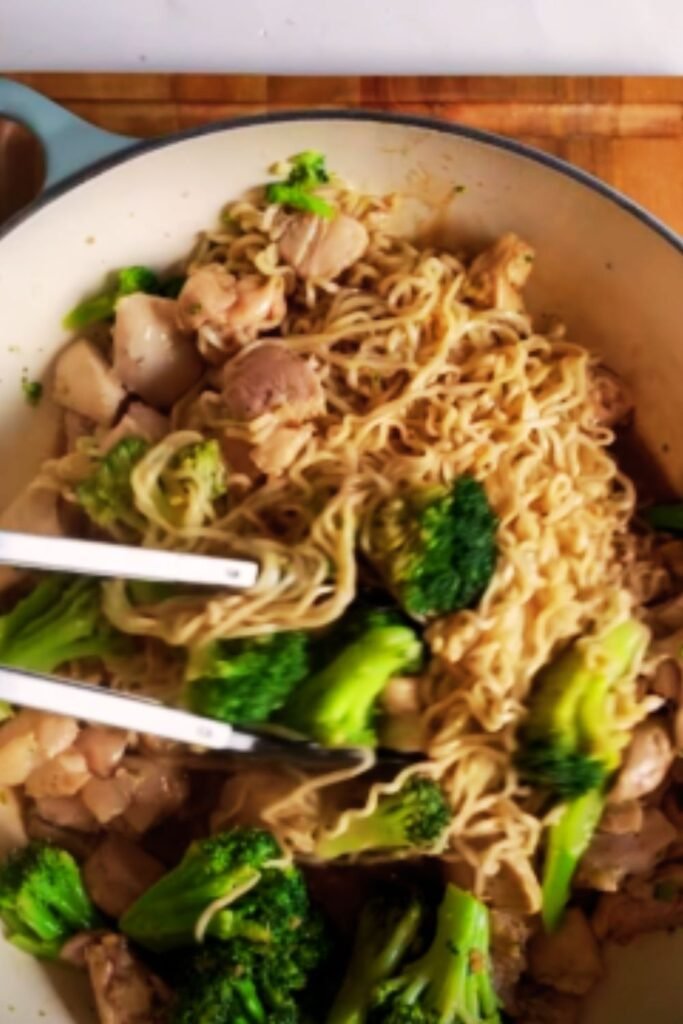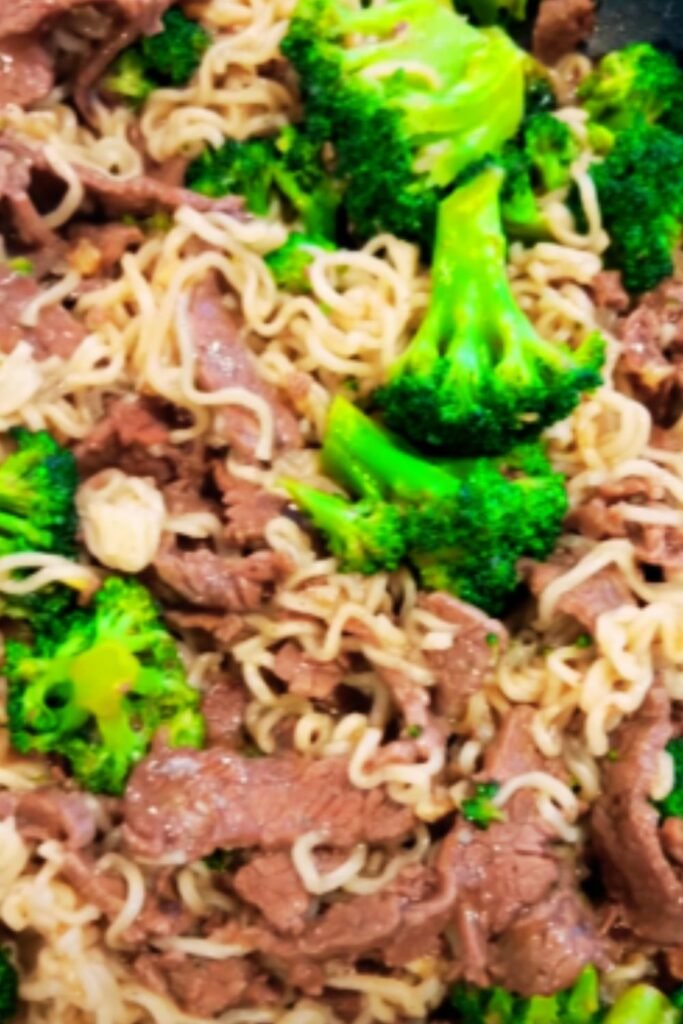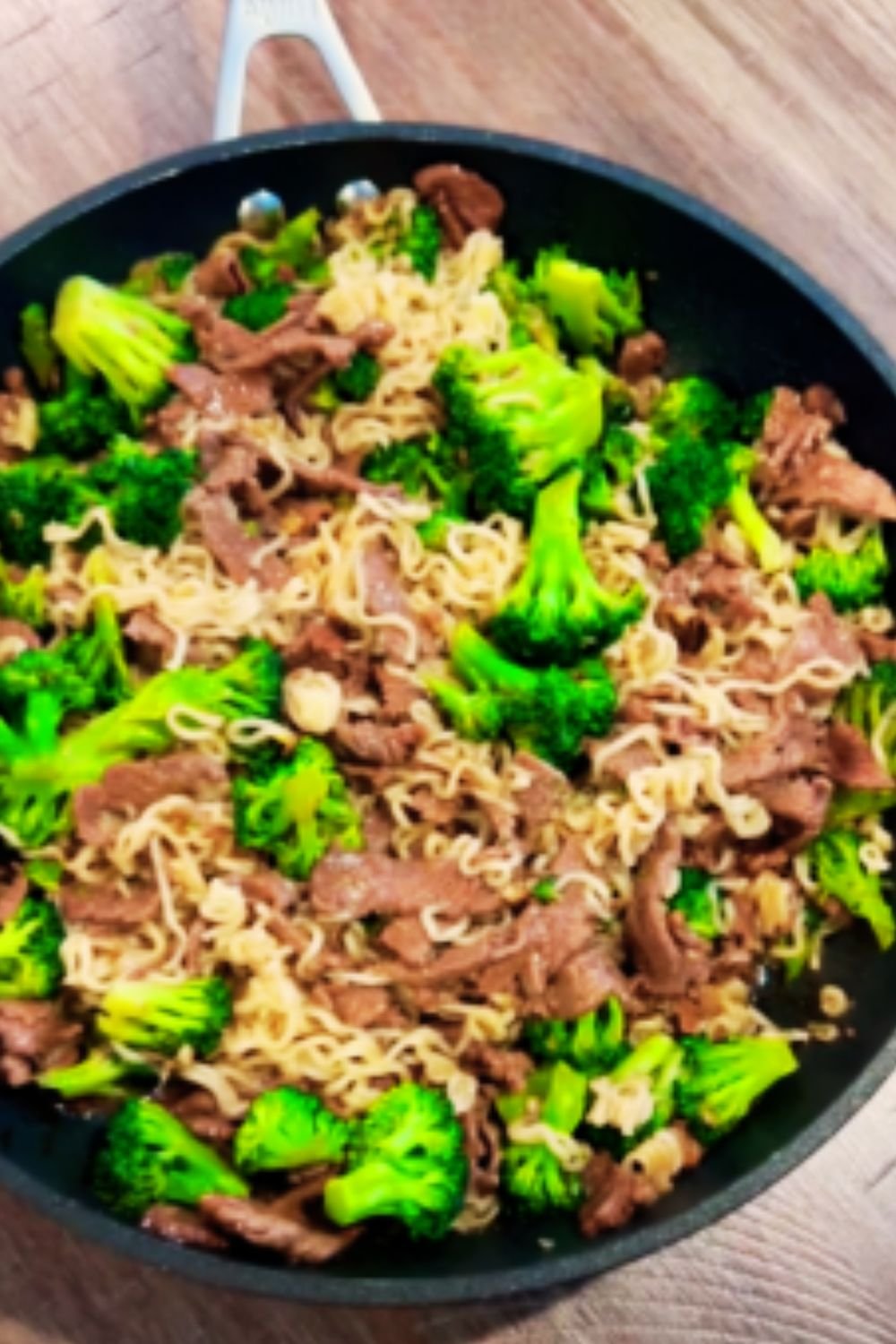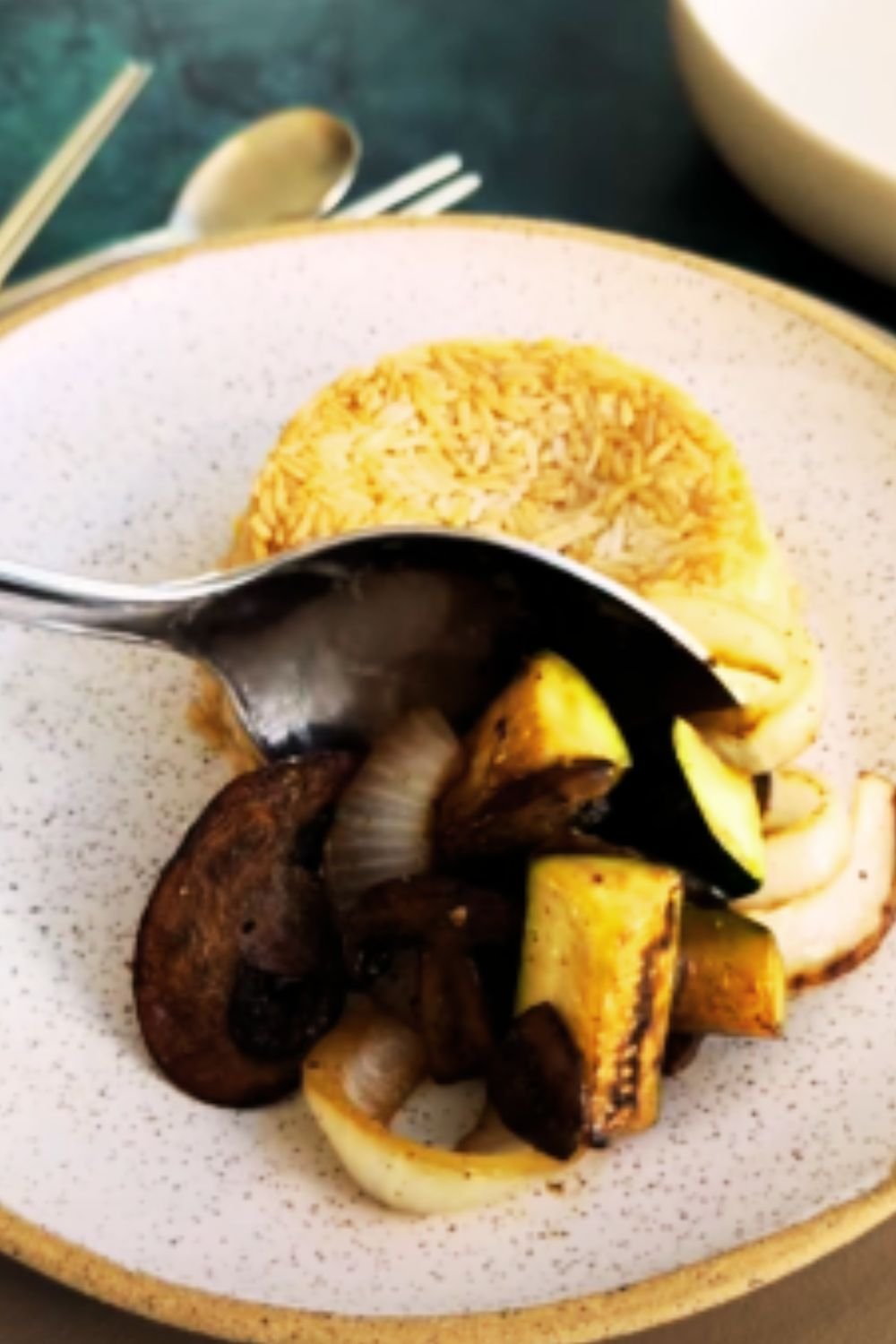There’s something magical about a good stir fry—the sizzle of the pan, the aromatic blend of garlic and ginger, and the satisfaction of creating a complete meal in just one pan. As someone who’s always on the hunt for quick, flavorful dinners that don’t skimp on nutrition, I’ve developed what I consider to be the ultimate mash-up: Beef and Broccoli Ramen Stir Fry. This dish combines the beloved flavors of classic beef and broccoli with the convenient comfort of ramen noodles, creating a meal that’s greater than the sum of its parts.
I remember the first time I made this dish. It was one of those hectic weeknights when the fridge was looking sparse, and I had about 20 minutes to get dinner on the table before hangry chaos ensued. With some thinly sliced beef in the freezer, a head of broccoli that had seen better days, and a couple packets of ramen noodles in the pantry, this recipe was born out of necessity—and it’s since become one of my family’s most requested meals.
What makes this dish special isn’t just its speed or simplicity, but the way it transforms humble ingredients into something that feels restaurant-worthy. The tender beef, crisp-tender broccoli, and chewy noodles all coated in a savory-sweet sauce that clings to every bite… it’s the kind of meal that makes you wonder why you ever ordered takeout in the first place.
So grab your wok (or large skillet), and let’s dive into this crowd-pleasing recipe that’s about to become your new weeknight hero.
The Perfect Beef and Broccoli Ramen: Ingredients Breakdown
Before we jump into the cooking process, let’s take a moment to understand what makes each ingredient in this recipe special:
Beef : I prefer using flank steak or sirloin for this recipe, sliced thinly against the grain. The key is cutting the beef into thin strips—about 1/4 inch thick—which ensures quick cooking and tender results. If you’re finding it difficult to slice thinly, try freezing the beef for about 15-20 minutes before slicing.
Broccoli : Fresh broccoli florets provide the perfect texture contrast to the tender beef and soft noodles. Cut them into bite-sized pieces that will cook quickly. The stems are actually delicious too—just peel the tough outer layer and slice them thinly.
Ramen Noodles : The star of the show! I use the dried ramen packages (usually 3 oz each) and discard the seasoning packets. These noodles cook incredibly quickly and soak up the stir fry sauce beautifully. You can use any type of ramen or even other quick-cooking noodles like soba or udon.
Aromatics : Garlic, ginger, and green onions form the aromatic base of this stir fry. Fresh is always best here, but in a pinch, you can substitute with garlic powder (1/4 tsp per clove) or ground ginger (1/3 tsp per tablespoon of fresh).
Stir Fry Sauce : The sauce is what brings everything together. It’s a balanced blend of soy sauce, oyster sauce, brown sugar, sesame oil, and cornstarch. Each component plays a crucial role:
- Soy sauce provides the salty umami foundation
- Oyster sauce adds depth and complexity
- Brown sugar balances the saltiness with a touch of sweetness
- Sesame oil brings a nutty aroma
- Cornstarch thickens the sauce so it clings to every bite
Garnishes : Sesame seeds and sliced green onions aren’t just for looks—they add texture and a fresh finish to the dish.
Essential Equipment
While this recipe doesn’t require any fancy equipment, there are a few tools that will make your stir frying experience more successful:
- A wok or large skillet: A 12-inch skillet or wok provides enough surface area for proper stir frying without overcrowding.
- A sharp knife: For thinly slicing the beef and cutting the broccoli.
- Wooden spoon or spatula: For quick stirring and flipping.
- Small bowl: For mixing the stir fry sauce.
The Recipe: Beef and Broccoli Ramen Stir Fry
Ingredients:
For the Stir Fry:
- 1 lb flank steak or sirloin, thinly sliced against the grain
- 4 cups broccoli florets (about 1 medium head)
- 2 packages (3 oz each) ramen noodles, seasoning packets discarded
- 2 tablespoons vegetable oil, divided
- 3 cloves garlic, minced
- 1 tablespoon fresh ginger, grated
- 4 green onions, sliced (white and green parts separated)
- 1 tablespoon sesame seeds, for garnish
For the Sauce:
- 1/4 cup low-sodium soy sauce
- 2 tablespoons oyster sauce
- 1 tablespoon brown sugar
- 1 teaspoon sesame oil
- 1 tablespoon cornstarch
- 1/4 cup water
Preparation:
- Prep the Beef: Slice the beef thinly against the grain. Place in a bowl and toss with 1 tablespoon of soy sauce and 1 teaspoon of cornstarch. Let marinate while you prepare the other ingredients.
- Make the Sauce: In a small bowl, whisk together soy sauce, oyster sauce, brown sugar, sesame oil, cornstarch, and water until smooth. Set aside.
- Cook the Noodles: Bring a pot of water to a boil. Add the ramen noodles and cook for 2 minutes (they should be slightly undercooked). Drain, rinse with cold water, and set aside.
- Cook the Beef: Heat 1 tablespoon of oil in a wok or large skillet over high heat. Add the beef in a single layer and let it cook without stirring for 1 minute to get a good sear. Then stir-fry for another 1-2 minutes until just cooked through. Remove the beef from the wok and set aside.
- Cook the Vegetables: Add the remaining oil to the wok. Add the white parts of the green onions, garlic, and ginger. Stir-fry for 30 seconds until fragrant. Add the broccoli and stir-fry for 3-4 minutes until crisp-tender.
- Combine Everything: Return the beef to the wok. Add the cooked ramen noodles and the sauce. Toss everything together and cook for 1-2 minutes until the sauce thickens and coats everything evenly.
- Serve: Garnish with the green parts of the green onions and sesame seeds. Serve immediately.
Cooking Tips for Success:
- Prep all ingredients before you start cooking: Stir-frying moves quickly, so having everything ready to go is essential.
- Don’t overcrowd the pan: Cook in batches if necessary to ensure proper browning.
- High heat is key: Keep your heat high to get a nice sear on the beef and to cook the vegetables quickly while maintaining their crispness.
- Work fast: Once you start cooking, the entire process should take less than 10 minutes.

Nutritional Breakdown
For those watching their macros or just curious about what they’re eating, here’s a detailed nutritional breakdown of this Beef and Broccoli Ramen Stir Fry:
| Nutrient | Amount per Serving | % Daily Value* |
|---|---|---|
| Calories | 425 | – |
| Total Fat | 17g | 22% |
| Saturated Fat | 5g | 25% |
| Cholesterol | 70mg | 23% |
| Sodium | 890mg | 39% |
| Total Carbohydrates | 40g | 15% |
| Dietary Fiber | 5g | 18% |
| Sugars | 6g | – |
| Protein | 32g | 64% |
| Vitamin A | 15% | – |
| Vitamin C | 135% | – |
| Calcium | 8% | – |
| Iron | 25% | – |
*Percent Daily Values are based on a 2,000 calorie diet
This dish provides an excellent balance of macronutrients with a good amount of protein from the beef, complex carbohydrates from the noodles, and fiber from the broccoli. The sodium content is something to be mindful of, but using low-sodium soy sauce helps keep it in check.
Variations to Keep Things Interesting
One of the best things about this recipe is how flexible it is. Here are some variations to try:
Protein Swaps:
- Chicken: Use thinly sliced chicken breast or thighs
- Shrimp: Reduce cooking time to just 1-2 minutes per side
- Tofu: Use extra-firm tofu, pressed and cubed
- Tempeh: For a meat-free option with a nutty flavor
Vegetable Options:
- Snow peas or sugar snap peas: Add during the last minute of cooking
- Bell peppers: Slice thinly and add with the broccoli
- Mushrooms: Slice and add after the aromatics
- Carrots: Julienne and add with the broccoli
- Bok choy: Separate leaves from stems, add stems with broccoli and leaves at the end
Sauce Variations:
- Spicy: Add 1-2 teaspoons of sriracha or chili garlic sauce
- Peanut: Stir in 1 tablespoon of peanut butter
- Citrus: Add 1 tablespoon of orange or lime juice
- Honey-Ginger: Use honey instead of brown sugar and double the ginger

Make-Ahead and Storage Tips
This dish is best enjoyed fresh, but there are ways to prep ahead and store leftovers:
Prep Ahead:
- Slice the beef and store in an airtight container in the refrigerator for up to 24 hours
- Chop all vegetables and store in airtight containers in the refrigerator for up to 3 days
- Mix the sauce and store in a jar in the refrigerator for up to 5 days
- Cook the noodles, rinse with cold water, toss with a little oil, and store in an airtight container for up to 2 days
Storing Leftovers:
- Store completely cooled leftovers in an airtight container in the refrigerator for up to 3 days
- Reheat in a skillet over medium heat with a splash of water to loosen the sauce
- Freeze in portion-sized containers for up to 2 months
- Thaw overnight in the refrigerator before reheating
Meal Prep:
For meal prep, I recommend keeping the components separate until ready to eat:
- Store cooked beef, vegetables, and noodles in separate containers
- Combine and reheat with the sauce when ready to eat
Serving Suggestions
While this dish is a complete meal on its own, here are some ideas to round out your dinner:
- Simple side salad: A light cucumber salad with rice vinegar dressing
- Miso soup: A small cup of miso soup makes a lovely starter
- Edamame: Steamed and lightly salted for a protein-rich appetizer
- Spring rolls: Fresh spring rolls with peanut dipping sauce
- Fruit: Fresh orange segments or pineapple chunks for dessert

Why This Recipe Works: The Science Behind the Stir Fry
Understanding the science behind cooking can help you become a better cook. Here’s why this recipe works so well:
The Beef Marinade: The brief marinade with soy sauce and cornstarch serves two purposes:
- The salt in the soy sauce helps break down the muscle fibers in the beef, making it more tender
- The cornstarch creates a protective coating that prevents the meat from overcooking and helps it retain moisture
The Cooking Order: There’s a reason we cook ingredients in a specific order:
- The beef goes first to benefit from the clean, hot surface of the wok
- Aromatics go in next to flavor the oil
- Vegetables are added according to their cooking time
- The sauce goes in last to prevent it from burning or over-reducing
The Sauce Thickening: The cornstarch in the sauce creates a chemical reaction when it hits the hot pan, causing the sauce to thicken and create that glossy coating that’s characteristic of great stir fries.
The Final Toss: Tossing everything together at the end allows the noodles to absorb the sauce and pick up all the flavors in the pan.
Common Questions and Troubleshooting
Let me address some common questions and potential issues:
Q: My beef turned out tough. What went wrong? A: Three possible issues: 1) The beef wasn’t sliced thin enough, 2) It was overcooked, or 3) It wasn’t sliced against the grain. Remember that high heat and quick cooking are key for tender beef.
Q: My sauce is too thin/thick. How can I fix it? A: For a thinner sauce, add 1-2 tablespoons of water or broth. For a thicker sauce, mix 1 teaspoon of cornstarch with 1 tablespoon of cold water and add it to the pan.
Q: Can I use different noodles? A: Absolutely! Udon, soba, rice noodles, or even spaghetti can work. Just adjust cooking times according to package directions and cook them slightly al dente.
Q: How can I make this dish gluten-free? A: Use gluten-free ramen noodles or rice noodles, and ensure your soy sauce and oyster sauce are gluten-free (tamari and many brands now offer gluten-free options).
Q: My broccoli is too crunchy/soft. How do I get it just right? A: For perfectly crisp-tender broccoli, you can blanch it in boiling water for 60 seconds before adding it to the stir fry. Or, for a one-pan method, add 2 tablespoons of water to the pan after adding the broccoli and cover for 1 minute to steam it slightly.
Q: Can I make this vegetarian/vegan? A: Yes! Substitute the beef with firm tofu, tempeh, or a plant-based meat alternative. For the sauce, replace the oyster sauce with vegetarian mushroom sauce or hoisin sauce.
Q: How can I reduce the sodium content? A: Use low-sodium soy sauce, reduce the amount of soy and oyster sauce by half, and increase the water in the sauce by 2 tablespoons.
A Personal Note: Why I Love This Recipe
I developed this recipe during a particularly busy season of my life when I needed meals that were quick, nutritious, and satisfying. What I love most about this dish is how it proves that “fast food” doesn’t have to mean unhealthy or flavorless.
The combination of tender beef, crisp broccoli, and chewy noodles creates a perfect balance of textures, while the savory-sweet sauce brings everything together. It’s a dish that feels like a treat but doesn’t leave you with that heavy, sluggish feeling that often comes after takeout.
I also appreciate how customizable it is. Whether I’m cooking for myself,


